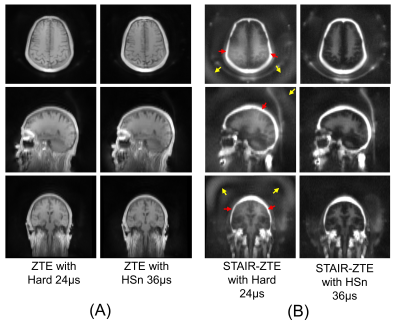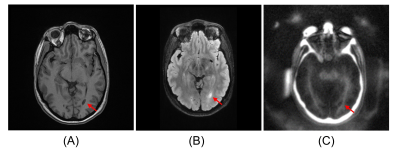Hyungseok Jang1, Yajun Ma1, Michael Carl2, Saeed Jerban1, Roland Lee1, Eric Y Chang1,3, Jody Corey-Bloom1, and Jiang Du1
1University of California, San Diego, San Diego, CA, United States, 2GE Healthcare, San Diego, CA, United States, 3Veterans Affairs San Diego Healthcare System, San Diego, CA, United States
1University of California, San Diego, San Diego, CA, United States, 2GE Healthcare, San Diego, CA, United States, 3Veterans Affairs San Diego Healthcare System, San Diego, CA, United States
In this study,
we investigated feasibility and efficacy of the proposed STAIR-ZTE sequence for
direct volumetric myelin imaging in human brain, which may provide an MR
biomarker for diagnosis and monitoring of demyelinating disorders.

Figure 3. Efficacy of HSn pulse (47-year-old male). (A) ZTE
imaging without IR and (B) STAIR-ZTE. A regular ZTE does not show a dramatic
difference between images with a hard pulse and an HSn pulse because the excitation bandwidths of both hard and HSn pulses are broad enough
to include the targeted region. STAIR-ZTE shows dramatic improvement with an
HSn pulse, where the low frequency signal bias (yellow arrows) affecting
myelin contrast (red arrows) is well suppressed. With suppression of long T2
signals, the remaining myelin signal becomes much lower and prone to imaging
artifacts.
